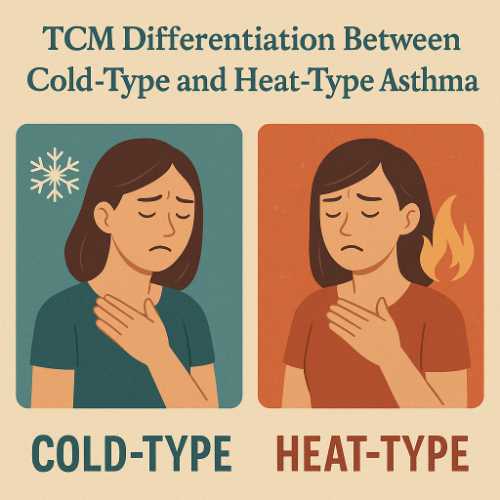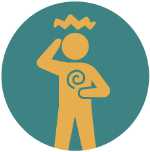TCM Differentiation Between
Cold-Type and Heat-Type Asthma
In Traditional Chinese Medicine (TCM), asthma is not treated as a single disease but as a manifestation of deeper imbalances in the body’s organ systems and energetic functions. One of the most important diagnostic tools in TCM is the classification of illness into cold and heat. This ancient way of understanding disease allows practitioners to tailor treatment specifically to the individual's underlying condition, not just the external symptoms.
Asthma, known in TCM as xiao chuan (哮喘)—meaning “wheezing and panting”—can present in either a cold-dominant or heat-dominant form. Both patterns may include coughing, shortness of breath, and wheezing, but their internal nature, causes, and appropriate treatments are very different.
Cold-Type Asthma
Cold-type asthma is typically characterized by constriction. The Lung qi becomes inhibited by internal cold, which causes the airways to tighten. Patients often report that their symptoms are worse in cold weather, early morning, or after exposure to cold air. The cough may produce thin, clear, or white phlegm, and breathing can become labored and shallow. Other signs include a pale complexion, preference for warmth, chills, and a slow, tight pulse. The tongue is usually pale with a white coating.
Cold-type asthma may result from constitutional weakness, chronic Lung qi deficiency, or external cold invasion. In many chronic cases, the Kidney system is also involved, especially if the breath lacks strength or worsens with fatigue.
Treatment for cold-type asthma focuses on warming the Lungs and Kidneys, resolving phlegm, and restoring the descending function of Lung qi. Herbs like Gan Jiang (干姜, dried ginger) or Xi Xin (细辛, Asarum) may be used to warm the interior. A classical formula such as She Gan Ma Huang Tang (射干麻黄汤) might be adapted for this purpose, along with acupuncture points that support qi movement and dispel cold, like (LU9 太渊 Tàiyuān) and (KI7 复溜 Fùliū).
Heat-Type Asthma
Heat-type asthma, in contrast, is associated with excess, inflammation, and obstruction. The person may feel hot, flushed, or restless. The cough tends to produce yellow or sticky phlegm, and breathing can be rapid or noisy. There may be chest tightness, thirst, irritability, a red tongue with a yellow coating, and a rapid pulse.
This form of asthma often arises from retained internal heat, long-standing phlegm accumulation, or emotional stress turning into heat. It can be triggered or worsened by diet—especially greasy or spicy foods—or seasonal heat and humidity.
Treatment focuses on clearing heat from the Lungs, resolving phlegm, and opening the airways. Herbs like Huang Qin (黄芩, Scutellaria) and Sang Bai Pi (桑白皮, Mulberry root bark) are used to reduce heat and calm wheezing. A common base formula is Ding Chuan Tang (定喘汤), which addresses both heat and phlegm with mild bronchial relief. Acupuncture points like (LU5 尺泽 Chǐzé) and (ST40 丰隆 Fēnglóng) are often selected to clear heat and transform phlegm.
Why Differentiation Matters
Treating a cold-type asthma attack with cooling herbs, or a heat-type pattern with warming tonics, can make symptoms worse. TCM diagnosis depends not just on the symptoms themselves but on the quality of the pulse, tongue appearance, season, and the patient’s constitution. It’s also common for chronic cases to present with mixed patterns—cold on the surface with heat inside, or vice versa—requiring careful balancing.
Recognizing the hot or cold nature of asthma symptoms helps both practitioners and patients understand why a one-size-fits-all approach doesn’t work. It reminds us that breathing is not just mechanical—it’s energetic, environmental, and deeply personal.
Vocabulary Guide
- Xiao chuan (哮喘) – Wheezing and panting; the TCM term for asthma
- Qi (气) – Vital energy or life force
- Gan Jiang (干姜) – Dried ginger, used to warm interior cold
- Xi Xin (细辛) – Asarum root, used for warming the Lungs and dispelling cold
- Huang Qin (黄芩) – Scutellaria, a cooling herb to clear Lung heat
- Sang Bai Pi (桑白皮) – Mulberry root bark, used to calm wheezing and reduce phlegm
- Ding Chuan Tang (定喘汤) – “Calm Wheezing Decoction,” used for heat-type asthma
- She Gan Ma Huang Tang (射干麻黄汤) – A classical formula used in cold-type asthma





